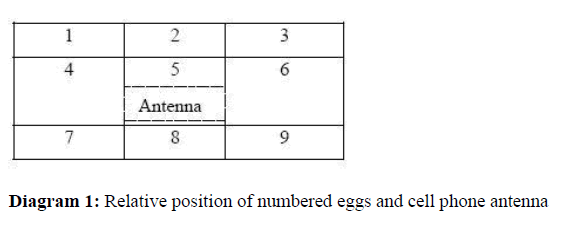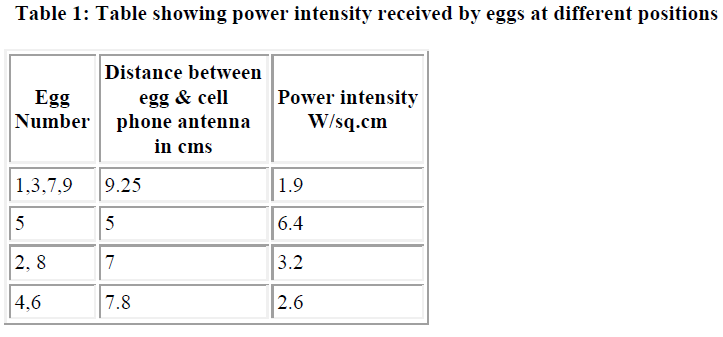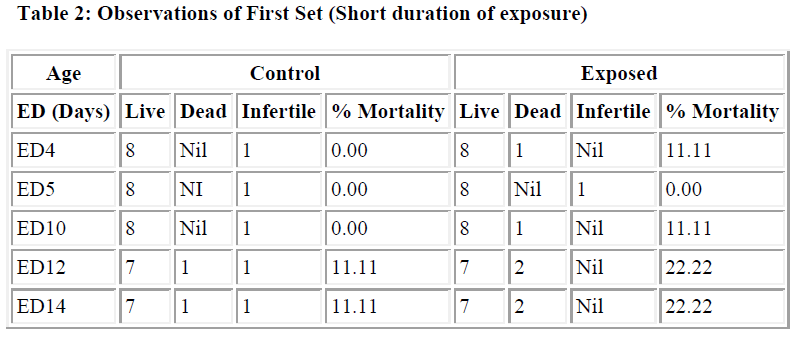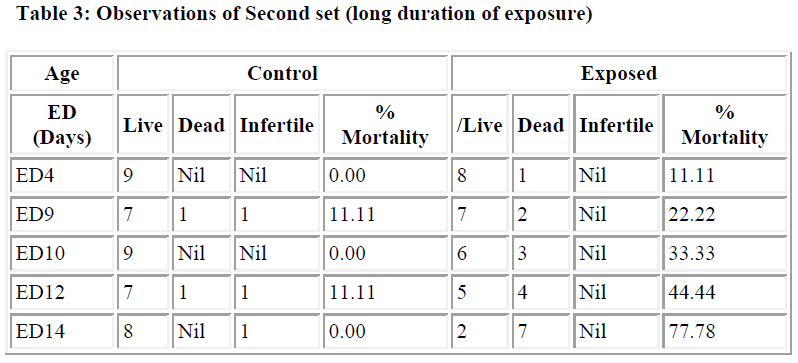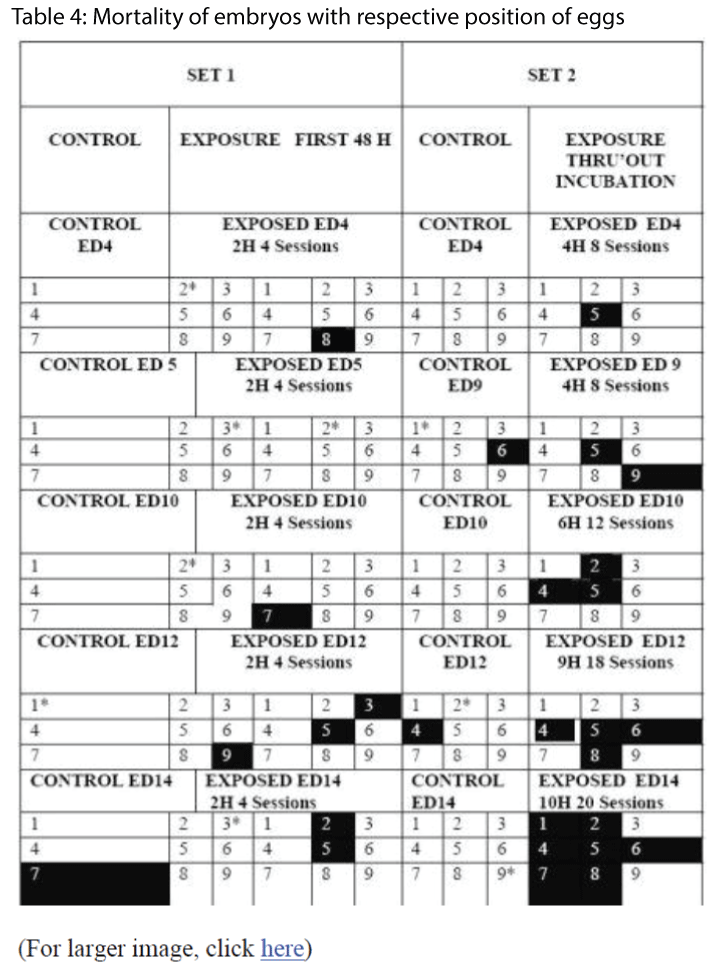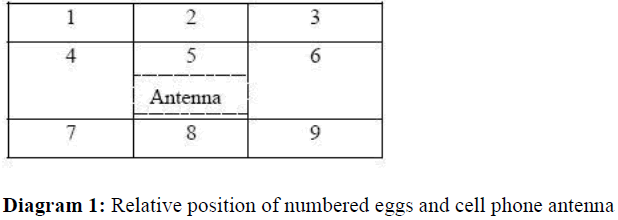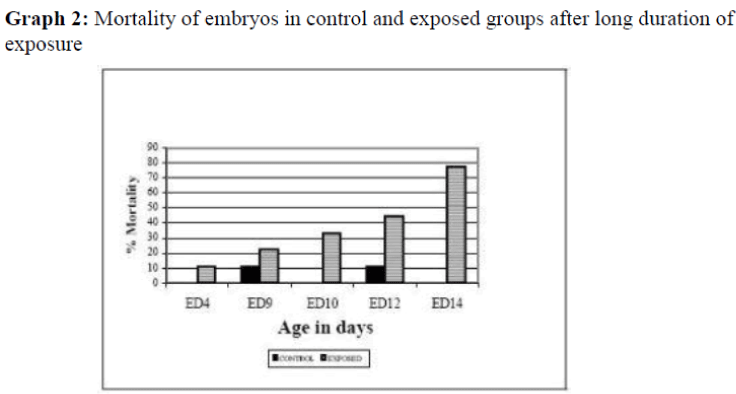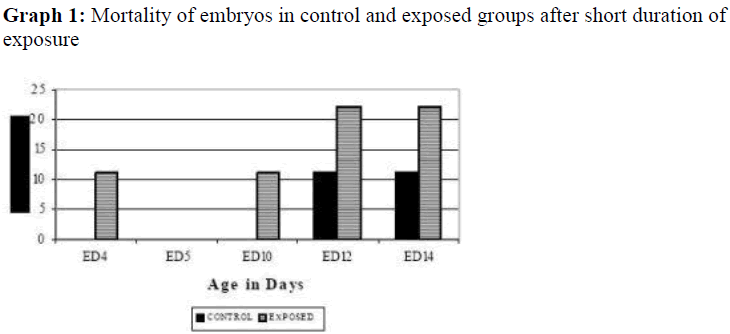ISSN: 0970-938X (Print) | 0976-1683 (Electronic)
Biomedical Research
An International Journal of Medical Sciences
- Biomedical Research (2006) Volume 17, Issue 3
Exposure to radio frequency radiation emitted by cell phone and mortality in chick embryos (Gallus domesticus)
I. V. Ingole* and S. K. Ghosh
Department of Anatomy, Mahatma Gandhi Institute of Medical Sciences, Sevagram, India
- Corresponding Author:
- I. V. Ingole
Department of Anatomy
Mahatma Gandhi Institute of Medical Sciences
Sevagram (Maharashtra) 442 102, India
e-mail: vijayingole ( at ) hotmail.com
Accepted date: September 24, 2006
The rapidly increasing use of cell phones since late 1990s has caused a general concern on the possible hazardous health effects of exposure to radio frequency electro-magnetic radiation (EMR) emitted by them. While considering the bio-logical effects of EMR on the human body, its intensity, frequency of radiation and duration of exposure are important determinants. Many researchers have reported several harmful effects associated with exposure to radio frequency EMR while some of the studies could not show any effect at all. The present study addresses the effect of cell phone emanating EMR in 900 MHz radio fre-quency (widely used) range in determining the health of developing chick em-bryos. A standard cell phone hand set working at a radio frequency band of 900 MHz, power of 2 W and Specific Absorption Ratio (SAR) 0.37W/Kg was used. Sets of fertile hen eggs (Gallus domesticus) in batches were incubated in a spe-cially designed incubator (radio transparent) at a constant temperature, humidity. During incubation one set of eggs was exposed for a short period and the other set was exposed for a longer duration to radiation of the cell phone while the remaining set of eggs was not exposed to any radiation. It was observed that exposure to radiation increased the mortality in chick embryos. It was further observed that the rate of mortality is the function of EMR energy comprising power density at the egg location and duration of exposure.
Keywords
Cell phone, EMR, radio frequency, radiation, mortality, chick embryo
Abstract
The rapidly increasing use of cell phones since late 1990s has caused a general concern on the possible hazardous health effects of exposure to radio frequency electro-magnetic radiation (EMR) emitted by them. While considering the bio-logical effects of EMR on the human body, its intensity, frequency of radiation and duration of exposure are important determinants. Many researchers have reported several harmful effects associated with exposure to radio frequency EMR while some of the studies could not show any effect at all. The present study addresses the effect of cell phone emanating EMR in 900 MHz radio fre-quency (widely used) range in determining the health of developing chick em-bryos. A standard cell phone hand set working at a radio frequency band of 900 MHz, power of 2 W and Specific Absorption Ratio (SAR) 0.37W/Kg was used. Sets of fertile hen eggs (Gallus domesticus) in batches were incubated in a spe-cially designed incubator (radio transparent) at a constant temperature, humidity. During incubation one set of eggs was exposed for a short period and the other set was exposed for a longer duration to radiation of the cell phone while the remaining set of eggs was not exposed to any radiation. It was observed that exposure to radiation increased the mortality in chick embryos. It was further observed that the rate of mortality is the function of EMR energy comprising power density at the egg location and duration of exposure.
Introduction
With the proliferation of personal wireless telecommunication instruments like cordless phones the cell phone has taken over the society by storm. Its compact size, low weight and ease of use have found millions of users. Though introduced only in 1990 the user base of cell phone has crossed 40 million marks within a decade espe-cially in a country like India. Unlike other electronic equipments the transmitter in the cell phones which radi-ates EMR happens to be close to human body hence it calls for an attention for its effects on human. Scientific researches have highlighted some extremely hazardous effects of exposure to radiation emitted by the cell phones on the human body like disruption of learned behavior, headache, fatigue, dysaesthesia etc [1,2,3]. Significant increases in single and double strand DNA breakages in rat’s brain cells have been reported [4] after exposure to radio frequency radiation. These changes at molecular level are potentially dangerous to the animal and may prove lethal. Radio frequency radiation exposure has been reported to induce changes in the prenatal development [5]. Effect of role of frequency modulation of microwaves on ornithine decarboxylase activity has been reported [6]. Use of cell phones has been incriminated as a risk for brain tumours [7]. Lethal effects leading to high rate of mortality were reported in chick embryos following exposure of eggs to cell phone radiation in the radio frequency bandwidth and 2W power [8]. Six times the mortality in the exposed chick embryos than that of the control group was reported by the above investigators. In another study, during the embryonic development chick embryo mortality was reported to have increased to 75% as a result of exposure to EMF from GSM mobile phone as compared to 16% in the control group [9]. Conversely some of the investigations have reported no adverse biological effects of exposure to radio frequency radiation emitted by the cell phone. The studies aimed to investigate the effects of microwaves emitted by cell phones on peripheral blood parameters of rats did not reveal any difference in the experimental group from sham-exposed group. But the birth weight of offspring in the experimental group was signifi-cantly lower than in the sham-exposed group [10]. Cyto-genetic investigations on microwaves emitted by a 455.7MHz car phone have failed to show any significant difference in chromosomal aberration or sister chromatid exchanges between microwave exposed human lymphocytes and unexposed control samples[11].
In considering the biological effects of exposure to radiation, the frequency, its power density and duration of ex-posure are the important determinants [12]. Regulatory organizations in different countries have established norms for human radio wave exposure and Specific Ab-sorption Ratio (SAR). Considering the controversial reports of the effects of exposure to RF radiation and the varying situations of exposure duration, frequency and intensity of radiation, the present article addresses the concern regarding the safety of exposure to radio frequency radiation emitted by handheld communication devices commonly known as cell phone handset on grow-ing embryos particularly of chick as a first pointer.
Materials and Methods
Fertile hen eggs were acquired from State Government Poultry Farm, Camp, Amravati 444602, India.
A popular brand cell phone hand set and service provider were selected with a frequency in the bandwidth of 900 MHz, power of 2 Watt and Specific Absorption Rate (SAR) of 0.37 W/Kg.
An egg incubator cubicle (W-35 cm, H-30 cm, and D-30 cm) made from specific heat resistant non-metallic material to avoid any internal reflection of the cell phone radiation within the enclosure was used. It had temperature and humidity controller with forced air ventilation. Fur-thermore it had an arrangement for automatic rotation of eggs twice a day. It had an arrangement for mounting the cell phone at on the top of the eggs. A radiation exposure duration meter (EDM) was used to measure the cumula tive time of cell phone radiation having an inbuilt control-ler to initiate the cumulative recording of time whenever the cell phone started radiating outgoing signal.
Positioning the eggs and cell phone
Eggs were arranged in 3X3 array and numbered as shown in Diagram 1. The cell phone antenna was kept at a distance of five cm above egg no.5. Calculated radiation power intensity for particular numbered egg is as shown in the Table 1.
The experiment was divided in the following sets:
First set (Short duration of exposure)
In the first set of experiment eggs were incubated in five batches of eighteen eggs each. Nine eggs from each batch were incubated in a standard egg incubator at 37± 0·5° C and 50-55% humidity without any exposure. Remaining nine eggs in each batch were incubated giving radiation in sessions of half an hour each and sessions spaced evenly at twelve hours interval. For exposure, the cell phone was placed in the incubator after dialing a particular number. The cell phone started emitting signal and the duration was recorded by the exposure duration meter (EDM). This was followed by a silent interval during which there was an automatic redialing but there was no emission of signal. After the redialing was complete, cell phone again started emitting signal and it’s duration was detected and recorded by EDM. Thus the total duration of exposure of half an hour in each session was not continuous but interrupted by short exposure-free periods. The exposed groups of all the five batches were exposed for four sessions, thus giving two hours of total exposure in the first forty eight hours of incubation. The eggs from these five batches were sacrificed at the completion of 4th, 5th, 10th, 12th and 14th day respectively (Table 2).
Second set (long duration of exposure)
Eggs were incubated in five batches of 18 eggs each similar to that of the 1st set.
Nine eggs in each batch were incubated as control in an incubator at 37±0.5°C and 50-55% humidity. Remaining nine eggs in each batch were incubated in the special in-cubator (as mentioned for the first set). Eggs were placed on the numbered slots and were incubated at 37±0.5 ° C and 50-55% humidity (as in the first set). The cell phone was placed in the same position as for exposed groups of first set. Exposures were given in sessions of half an hour each, spaced at 12 hrs intervals. Duration of exposure was recorded by EDM. The five batches were exposed to radiation exposure schedules of four h, four h, six h, nine h and tens h respectively. These five batches were sacrificed at the completion of 4th, 9th, 10th, 12th and 14th day of incubation respectively (Table 3). The embryos were taken out and observed for viability and gross morphology.
Observations and Discussion
First Set: (short duration of exposure)
At the completion of 4th, 5th, 10th, 12th and 14th day of in-cubation, the condition of the embryos in the control group receiving no radiation and the condition of the embryos in the exposed group receiving exposure to radia-tion during the first 48 h of incubation is tabulated in Ta-ble 2.
Second Set: (long duration of exposure)
In the control groups where no exposure was given, at the completion of 4th, 9th, 10th , 12th and 14th day of incubation, the condition of the eggs was as shown in Table 3.
In the exposed groups from this long exposure set, where total exposures were four hours, four hours, six hours, nine hours and ten hours respectively, at the completion of 4th, 9th, 10th, 12th, and 14th day of incubation, the condition of eggs is shown in Table 3. Status including the mortality of embryos in all above experiments is shown in Table 4. The embryo [5] underlying the antenna having an exposure of 6.4 mW/sq.cm was consistently found dead in all the batches of exposed groups of second set (Table 4).
In the present work, the mortality of chick embryos with a short exposure (2 h) to cell phone EMF did not show significant difference between the exposed group and that of the control group in the initial period of incubation. While with the same dose of radiation exposure, as the incuba-tion was allowed to progress, mortality was found to be higher than that of control group in the later days of incubation (Graph1). Since in the short exposure schedule, no significant difference in the mortality between 4th and 5th day was noted, the 5th day schedule was omitted in the second set of experiment and the incubation was allowed to progress up to the completion of 9th day with the same dose of exposure as for 4th day schedule i.e. 4 h. In this batch 2 embryos were found dead (Table 3). Both these findings may be attributed to some delayed effect of ex-posure to radiation.
In our experiment with longer duration of exposure (second set), the exposed groups had a higher mortality rate compared to their control counter parts in all the batches (Graph 2). Also the mortality of embryos exposed to radiation for a longer duration was significantly higher than those exposed for a shorter period (Graph 3). It was observed that in the batches incubated for a longer period, there was a significant increase in the mortality rate of embryos as the duration of exposure increased. These results are much in conformity with the reports of the work of Saito et al [13], who reported lethal and terato-genic effects in chick embryos following exposure to 428 MHz frequency radiation at a power density of 5.5 mW/cm2 where low level radiation was applied throghout the incubation period over 20 days. Lethality amounted to 60% in the exposed group (against 16% in the control group) where SAR ranged from 3.1 to 47.1 mW/kg. varying with the position of the egg in the field. In our work the radiation was at higher frequency (900MHz) and SAR also higher (0.37 W/Kg.), which possibly accounted for the higher mortality (77.78 ) in the exposed group (long exposure). Similarly Youbicier et al [8]) also reported six fold increase in the mortality of chick embryos as a result of exposure to cell phone radia-tion with a frequency of 900 MHz compared to control group. In the work of above researchers the exposure was given continuously throughout the incubation period whereas the significance of the finding of the present work lies in the fact that the duration of exposure is intermittent similar to day-to-day use. In another study, Gregor’ev Iug reported 75 mortality of chick embryos during embryonic development as a result of exposure to EMF from GSM mobile phone as against 16% in control group [9]. Details like frequency and SAR could not be ascertained in this case.
On the longer duration exposure experiment, the embryo no. 5 lying right under the antenna having been exposed to power intensity of 6.4 mW/sq.cm was found dead in all the five batches. Embryo no. 2 and no. 8 exposed to the 3.2 mW/sq.cm power intensity survived in the initial batches but were found dead in the batches receiving an exposure of six hours and more. The embryo no. 4 & 6 exposed to 2.6 mW/sq.cm power intensity radiation were found dead in the last two batches receiving an exposure of 9 h and 10 h respectively. Embryos no 3 and 9 exposed to 1.9 mW/sq.cm power intensity were found to be alive in all the batches except one embryo in the batch sacrificed on the completion of 9th day. Similarly embryos no. 1 and no.7 exposed to 1.9 mW/sq.cm power intensity sur-vived in all the batches except the last one receiving long-est exposure. (Dia.2 & Table1). It shows that the power intensity plays a significant role in causing the mortality of chick embryos.
Conclusion
The present work shows that radiation emitted from cell phone causes an increase in the mortality of chick embryos which depends on the increase in energy of dose comprising the exposure in the form of increased duration and power intensity of cell phone operating in the frequency range of 900 MHz and 2 watt power. High rate of mortality in the exposed groups is indicative of tissue damage, which is being investigated.
References
- Hocking B. Preliminary report: Symptoms associated with mobile phone use. Occup.Med 1998; 48: 357-360
- Hocking B, Westerman R. Neurological abnormalities associated with mobile phones. Occup Med 2000; 50:, 366-368
- Bastide M, Youbicier-Simo BJ, Lebecq JC, Giaimis J. Toxicologic Study of electromagnetic Radiation emitted by Television and Video Display screens and Cellular Telephones on chickens and mice. Indoor Built Environ 2001; 10: 291-298
- Lai H, Singh NP. Single and double strand DNA breaks in rat brain cells after acute exposure to low level radio frequency electromagnetic radiation. Internl J Rad Biol 1996; 69: 513-521.
- Magras IN,. Xenos TD. RF radiation induced changes in the prenatal development of mice. Bioelectromagn 1997; 18: 455-461
- Penafiel L. M., Litovitz T., Krause D., Desta A., Mullins J. M. Role of modulation on the effect of microwaves on ornithine decarboxylase activity in L 929 cells. Bioelectromagn 1997; 18: 132-141.
- Hardel LL, Nasman A, Pahlson A, Hallquist A, Mild KH. Use of cellular telephone & the risk for brain tumours: A case control study. Internatl J Oncol 1999; 15: 113-116.
- [Missing]
- Youbicier-Simo J, Lebecq JC, Bastide M. Mortality of chicken embryos exposed to EMFs from mobile phones. Presented at the Twentieth annual Meeting of the Bioelectromagnetics Society, St. Pete. Beach Fl. June 1998.
- Grigor ev Iug. Biological effects of mobile phone electromagnetic field on chick embryo (risk assessment using the mortality rate). Radiots Biol Radioecol, 2003; 43: 541-543.
- Dasdag S, Akdag M.Z., Ayyildiz O., Demirtas O. C., Yayla M., Sert C. Do cellular phones alter blood parameters and birth weight of rats? Electro and Magne-tobiol 2000; 19: 107- 113.
- Maes A, Collier M, Verschaeve L. Cytogenetic investigations on microwaves emitted by a 455.7 MHz car phone. Folia Biologica 2000; 46: 175-180
- Kues H. A., D?Anna S. A., Johnson M.A., Green W.R., Brooks L. J., Monahan J. C. The importance of specific micro wave parameters for the induction of ocular ef-fects in the nonhuman primate. Sixteenth Annual Bio-electromagnetics Conference 1994; (Abstract) pp.7
- Saito K., Suzuki K., Motoyoshi S. Lethal & teratogenic effects of long term low-intensity Radio Frequency radiation at 428 MHz on developing chick embryo. Teratology 1991;43: 609-614
